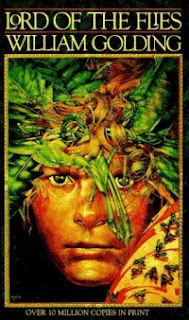Belinda's Joke Corner
Q: What do you call an alligator that's been roughed up in a fight?
A: An allegory!
Okay. That's not true at all, and it's not a very good joke, either, but Lord of the Flies, (like Animal Farm by George Orwell for those of you who have read that one), is an allegory.
An alle-what?
An allegory is a story in which objects and characters within the story also have meanings outside of the story. Because of this, an allegory typically tells two stories at the same time: a literal story, a.k.a, what's actually happening from moment to moment, and a bigger picture story that can be figured out by determining what the specific characters and objects represent.
This is exactly what's going on in Lord of the Flies—it tells two stories. First, there is the literal
story: the plane crash that strands a group of private school boys on an
island and all of the events that follow. Second, there is the “bigger picture”
story that can be understood when we look more deeply at what various
characters and objects symbolize.
Symbolism in the Shadows
As you read Lord
of the Flies, be on the lookout for symbolism.
A symbol is something that stands
for something else. For instance, the American flag is our national symbol—it
stands for the United States; it can also be seen as a symbol of “freedom” or “patriotism.”
In Lord of the
Flies, you will find several symbols. Piggy’s glasses, for instance, are
symbolic, though I’ll let you try to figure out what it is they represent.
You
will also find many motifs in this
book. A motif is an object, image,
word, phrase, or action that is repeated throughout a story.
Two motifs in Lord of the Flies—images that arise
over and over again—are shadows
and masks.
Motifs help to unify a
story, and are often used to suggest greater meaning. See if you can figure out what Golding is doing with the motifs of
shadows and masks in Lord of the Flies.
Why does he repeat them so often? Is there something he is trying to tell us or
make us think about?
It’s okay if you don’t come up with an answer. I
just want you to be thinking about it. If you notice other symbols or motifs (and
yes, there are more), be sure to make a note of them so we can talk about them
when we meet in November.
And, as usual, here are a few assignments for you to choose from. Please come prepared with a thoughtful answer for at least one of them.
The Assignments
Option #1: Symbols & Motifs
Focus on one of the symbols or motifs mentioned above—or one of your own—and locate as many quotes as you can pertaining to that symbol. Use these quotes to help you determine what, exactly, the purpose of this particular symbol or motif is. What is Golding using this symbol or motif to suggest to us? Be ready to point to your quotes to support your assertions. Feel free to create a visual illustration of a symbol or motif to aid in your explanation.
Option #2: What's up with Simon?
Scrutinize the passages in which he is featured. Look at his physical description, pay attention to his actions, and try to figure out what his role is in both the literal story and the allegory. Put together some notes, bullet points, a collage, or a brief essay in which you answer the initial question: What's up with Simon?
Option #3: Be the timekeeper!
How long are the boys on this island? A ballpark figure is fine, but be sure to be ready to show us how you came to your answer. How does Golding show us that time is passing?
Option #4: Title Track
Who or what exactly is the “Lord of the Flies” and what is the significance of the book's title? Find the passage where the title appears in the text of the book and explain the significance of this scene.
Happy reading!
Belinda

No comments:
Post a Comment